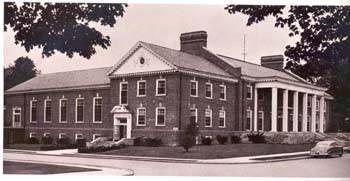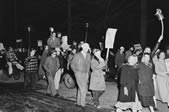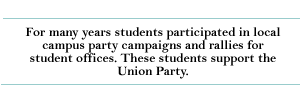
Pages:
<< Back 1
2 3 4
5 6 7
8 9 10
Next >>
As
early as Old Gold Day 1945 students and alumni had begun a campaign
to raise funds for a student activities building that could serve
as an all-campus center for recreation and social life. The result
was the construction of the Memorial Student Union Building, opened
in 1951 and dedicated to the memory of the more than 100 DePauw
students who had lost their lives in World War II. Designed by the
Indianapolis architectural firm of McGuire and Shook in the prevailing
Georgian Colonial style, the L-shaped building on the corner of
Locust and Hanna Streets had at its main entry a broad portico supported
by six columns facing the women's dormitory quadrangle. Inside were
a ballroom-auditorium, cafeteria and dining room, bowling alleys
and billiard room, and a large central reception hall. Space was
also found for the Alumni Office and a faculty lounge. A patio overlooked
the East College lawn.
The new Union Building also contained specially designed studios
for DePauw's 10-watt radio station, WGRE-FM. Radio broadcasts had
begun on a regular basis from the DePauw campus as early as April
1941, when an arrangement was made with station WIRE in Indianapolis
to carry two or three 15-minute educational programs a week from
an improvised studio in the psychology department's experimental
laboratory on the third floor of Harrison Hall.

____________________________
The Memorial Student Union Building
was completed in 1952 in memory of
the DePauw students who died in
World War II.
____________________________
In 1948 Herold Ross of the speech department, who had been named
director of the radio program in 1945, applied to the Federal Communications
Commission for a license permitting the university to operate a
10-watt F.M. station. The license was granted, and in April 1949
station WGRE-FM began broadcasting from studios in Rooms 318 and
319 of Harrison Hall, using a transmitter donated by the General
Electric Corporation. Named as program director to assist Ross,
who became the station director, was a new member of the speech
department who was to exert a major influence on the development
of radio at DePauw, Elizabeth Turnell. In May 1951 WGRE turned back
its studios in Harrison Hall to the psychology department and moved
its operations to the new and improved facilities in the Memorial
Student Union Building. Since then DePauw students have broadcast
a wide variety of programs daily during the college year. In 1962
permission was obtained from the FCC to increase the station's power
to 250 watts.
Some changes in departmental organization took place in the war
and postwar years. In 1942 the Latin and Greek departments, which
had suffered losses in enrollment with the growth and interest in
modern languages, were consolidated as the department of classical
languages. Four years later the departments of philosophy and religious
education were also merged into a single department of philosophy
and religion; Bible, however, remained a separate department until
1955. In the natural sciences the botany department added bacteriology
to its title in 1947 to reflect an expansion of its course offerings
in that area, and the geology department in 1948 added geography
after having already listed courses in that subject in its curriculum
for some years.


Shortly after the war's end Professor Hans Gruéninger revived
and enlarged the foreign study program begun in the mid-1930s. Student
exchange programs with foreign universities in Europe and Latin
America were revived and new ones instituted, notably with the Universities
of Durham and Exeter in the United Kingdom. Selected DePauw undergraduates
spent their junior year studying in Austria, Colombia, Denmark,
Equador, France, Germany, Great Britain, Mexico, the Netherlands,
Norway, Spain, Sweden, and Switzerland. A smaller number of foreign
students attended classes at DePauw, living in dormitories and Greek-letter
living units and participating to a large degree in the life of
the campus.
Student life returned to normal after the austerities of wartime.
Proms and other all-campus parties were held in the spacious ballroom
of the new Student Union Building, while all the social fraternities
reinstated an active social calendar. Greek-letter life was strengthened
with the addition of a chapter of Sigma Alpha Epsilon for men and
two new women's organizations: Pi Beta Phi and Delta Gamma.
Independent men and women also sought a larger voice in student
affairs. In 1947 an Association of Independent Women was organized
which lasted several years before disbanding. The well-established
Men's Hall Association was especially active in promoting interracial
housing at DePauw. As a result of their concern the administration
assigned black males, who had formerly lived out in town, to rooms
in Longden Hall in 1948. Black women, however, had to wait until
1955 to live in university residence halls.
The university re-emphasized its historical relationship with the
Methodist Church while recognizing the growing religious diversity
of its student body. In 1944 an interdenominational Council on Religious
Life was formed, composed of representatives of the students, faculty,
and administration. It took responsibility for the weekly vesper
services on Sunday evenings and for Religious Emphasis Week, a series
of special meetings held each spring dealing with the application
of religion to personal and social life. Led by prominent preachers,
these meetings provided a substitute for the evangelistic services
once a regular feature of the Indiana Asbury-DePauw religious scene.
The daily chapel services were reduced, first to three or four mornings
a week, and finally to one chapel service on Wednesday in Gobin
Methodist Church and a Friday convocation in Meharry Hall devoted
to a musical program or a lecture, often by an outside speaker.
In the early postwar years the faculty studied ways of strengthening
the program of general education at DePauw. One result was the creation
in 1948 of an area major, consisting of 48 semester hours in related
fields, cutting across departmental lines. A special faculty committee
devised an Experimental Curriculum during the 1947-48 academic year.
Designed to introduce students to major areas of knowledge by integrating
subjects normally taught separately, it included four-hour courses
in physical science, biological science, the history of civilization,
the social sciences, and basic communications. The last covered
both oral and written composition. Fifty students enrolled for the
first classes, but the number eventually declined. Originally approved
for a five-year period, it was later extended to seven years.
In 1950 DePauw University completed arrangements for a binary pre-engineering
program with Rose Polytechnical Institute, Case Institute of Technology
and the Carnegie Institute of Technology. The plan called for three
years on the DePauw campus and two years at one of the cooperating
institutions, at the conclusion of which students would receive
a B.A. from DePauw and a B.S. from the engineering school. A somewhat
similar program for forestry was arranged with Duke University and
a cooperative system of nursing education with Methodist Hospital
in Indianapolis.
Back
to Top
Pages:
<< Back 1
2 3 4
5 6 7
8 9 10
Next >>
|



